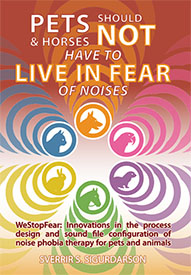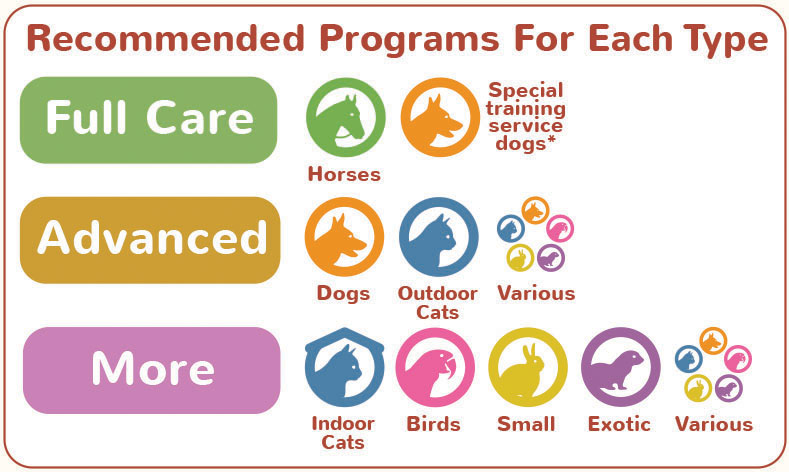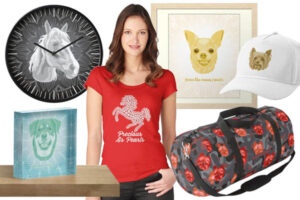 The text on this page is from the book "Pets and Horses Should Not Have To Live In Fear Of Noises" The book is available on Amazon.com as Print version or Kindle version.
The text on this page is from the book "Pets and Horses Should Not Have To Live In Fear Of Noises" The book is available on Amazon.com as Print version or Kindle version. Table of Contents
Table of Contents 4
Story flash: The sunny city park isn’t nice for all 14
Part 1: A problem for animals in our modern world 23
Why are millions and millions of dogs burdened by unnecessary fear? 23
Much more common than many common dog diseases 23
Up to or even more than 50% of dogs may experience from time to time some reduction of their joy of life 25
Other research outcomes 26
The dog owners are not doing something “wrong“ 27
Some examples of dogs’ problems from various sources 27
Other types of animals can have problems 30
Cats 30
Some cat problem examples from various sources 31
Pet birds 32
Some bird examples from various sources 33
Small mammals 34
Some small mammal examples from various sources 35
Horses 37
For horses especially more is needed 38
Desensitization, sensitization, habituation, counterconditioning 39
Some examples of horse problems from various sources 39
Exotic pets 42
Some exotic pets examples from various sources 43
Animals that are less sensitive 46
The other types of pets are loved as much as dogs 46
WeStopFear for ALL TYPES of sensitive pets 47
Why are they frightened? 48
The sympathetic autonomic nervous systems 48
The para-sympathetic autonomic nervous system 48
Fear of thunderstorms can be a very serious problem 49
Other things can be scary as well 51
Fear or phobia: The difference 52
This stretches millions of years back 53
Roots in the past: Six million years ago, canids appeared 53
A 100,000 years ago, humans went on foot 54
How wolves and wild cats became parts of human families (the author’s theory) 55
Ooh, it is so cute... let’s not kill it right away... 56
Isn’t this a plausible explanation of how cats and dogs were domesticated? 58
You see this phenomenon on the Internet 59
The first domesticated animal 59
The world of nature 59
The mildness of nature’s sounds 60
Only a fraction of their time being with humans 61
The fear instinct is a necessary survival tool 62
They have spent 1% of their time on earth with humans 62
0.01% of their time exposed to the industrialized world 63
Unknown, sudden, and forceful noises 64
“Help, I am trapped!“ 65
The fear may escalate... 65
They don’t know the noises are harmless 66
The well-meaning dog owner may not have a clue 67
Any dog can become fearful and at any age - we don’t know which one will 67
Today’s industrialized and noisy man-made world is like an attack on dogs’ ears 68
If fear is so common, why aren’t dog owners doing something? 68
You cannot explain with words 69
This fear is understandable when we think about it 70
Story flash: A refreshing walk in the country turns scary 71
Part 2: The remedies available until now 76
What can be done to prevent this fear? 76
The key to the solution is habit 76
A look at the methods 77
Desensitization and habituation 78
Desensitization according to Wikipedia 78
Habituation according to Wikipedia 79
Sharpening the understanding of what these terms mean here 80
Associative learning 80
Other methods of treatment 81
Additional remedies during thunderstorms or fireworks 82
Medication prescribed by veterinarians 83
Applying a combination of methods can be advisable 83
Preventive measures could greatly improve the overall situation 84
The very best time is to start during puppyhood of 3-8 weeks old 84
Puppies’ natural fear periods 85
You can conduct desensitization at any age 85
The best starting time for other types of pets and horses 86
Kitten 86
Foals 87
Pet birds 88
Small mammals 88
Exotic pets 89
The basic method of desensitization – description and possible drawbacks 89
Starting low and gradually increasing the volume, so the dog gets used to the sounds 90
In the end at full natural volume 90
Getting used to the sounds in the places where they are played: Locational tolerance 91
Precision and perseverance are important 91
Why isn’t this method more widespread? 92
Two desensitization methods today: The “classical“ one-file, and the “music mix“ method 92
The classic one-file method of noise phobia therapy - features and drawbacks 92
Too loud, too early is a risk 93
Meticulous management and even keeping records is necessary 94
It should come as out of nowhere 95
Too much of a “good“ thing 95
A therapy not finished helps no one 96
The “music mix“ solution: Features and drawbacks 96
Baroque and classics 96
Trouble making sounds appear gradually inside the music 97
Always the same volume setting, so that is simpler 98
Watching the time very closely is necessary 98
Only a limited breadth of sound types currently 99
Again, it’s like a scientist at work 99
Part 3: The new method of WeStopFear 101
The new method with a new process design 101
Process analysis, process re-design, re-engineering and quality management 102
The ten factors of how WeStopFear is meant to be better 103
Safer, easier and simpler with Timed Access™ 103
More natural and more tolerable 104
For all types of pets and companion/recreational animals 104
Comprehensive Instructions 105
Future Maintenance 106
Affordable for all 106
More comprehensive programs for better tolerance 107
Texts describing the four programs 109
Basic program 110
More program 110
Advanced program 110
Full Care program 110
The four innovations 110
1. Simple Secure Steps™ 111
2. Volume Anchor™ 111
3. Timed Access™ 111
4. Ascending Loudness™ 113
How the Simple Secure Steps™ and Volume Anchor™ work together 113
The volume setting is always the same 114
Each step has the correct volume level of the sounds 115
5. Natural Intervals™ 117
Random playback with variable silences 118
A simple implementation and more bearable 119
The basic workings of the therapy methods are the same 120
A detailed comparison of the classical method and the Simple Secure Steps method 121
Different factors listed 121
Similar factors listed 122
Overview of different factors: 122
A systematically thought-out process design 122
Setting the volume (on different types of playback devices) 123
The number of soundtrack sets 125
Timed access to audio track sets 127
The continuity of the sounds and natural silences in between 128
Comprehensiveness of instructions 130
Types of animals served 132
Ongoing encouragement in future maintenance 135
Cost of using the solution 135
Overview of similar factors: 136
The same basic function 136
A set of therapy sounds 136
Choice of locations 136
Choice of audio playback device(s) 136
Different volume settings in different locations on an audio device 137
The user’s path through the process 137
Instructions 138
Determine locations 139
Playback Devices 139
Volume setting 139
Start the process: Step 1 140
Behave correctly and stay happy 141
From Step 1 to Step 2 141
Progress through the Steps 142
The ongoing Maintain Success stage 142
It is as simple as this 143
What this means for the pet or horse 143
MP3 sounds and audio CD discs 143
Video therapy 144
Is this new method the best method available? 147
First analogy: The car starter 147
Second analogy: Manual and automatic transmission in cars 149
Third analogy: The simple sneaker, and the sophisticated high-tech running shoe 150
The new solution is slightly more complicated, but is designed to be simpler and easier to manage for the human user 151
Which one is better? It will be a personal choice 152
The situation among pets and horses would improve if all pet owners would do noise phobia therapy 154
Things people do to reduce risk 155
A new standard practice? 155
The goal is for the maximum number of pets to be able to benefit from this new system 156
Three goals need to be met 157
Mobilize the world: 500,000,000 (500 million) households! 158
Be welcome to use WeStopFear 159
Part 4: The history of this project – what has happened – how did it develop? 160
The story behind the innovations: A long journey 160
Dogs and horses in trouble during new year’s 161
3 billion dollars’ worth of fireworks in 30 minutes? 161
What about police dogs and police horses? 162
Fantastic! A solution existed! 162
Why isn’t it widespread? 163
A process too demanding on the ordinary dog owner? 164
Seemingly small things can be a threshold 165
Lower quality of life is the result 166
A slightly better solution 166
The CD disc and website Sound Phobia Free 167
Looking at things as an outsider: The four innovations born 170
The CD was dying, and the future was digital files 171
The website Flugeldahljod.com or “fireworks sounds” 172
Featured on national TV, radio and newspaper 174
Prevent Fear 178
WeStopFear developed 178
Several brand names 180
TopFauna logo, designed by the author 183
A designer brand to support WeStopFear 183
Today: WeStopFear ready to welcome users 187
About the author, developer of the Simple Secure Steps therapy solution design, and founder of WeStopFear.com 189
References 190
General references 190
Dog references 191
Cat references 194
Pet bird references 195
Small mammals: 196
Rabbit references 196
Guinea pig references 196
Hamster references 196
Horse references 197
Exotic pets: 198
Ferret references: 198
Vietnamese pot-bellied pigs references: 199
Degus references: 199
Chinchilla references: 199
Sugar gliders references: 199
Gerbil references: 200
Fancy rats and fancy mice references: 200
Hedgehog references: 200
Fennec fox references: 200
Choose your pet type or horse solution introduction:
Dogs, outdoor cats, indoor cats, horses, pet birds, small mammals, exotic pets, and households with various types of pets.
(Small mammals include rabbits, guinea pigs and hamsters. Exotic pets include chinchilla, degu, fancy mice, fancy rats, fennec fox, ferret, gerbils, hedgehog, sugarglider and pot-bellied pig. Various types of pets are any pet types combination excluding horses.)

Front Pages Links
Types Solutions
Programs
Overview
Walk through screencast video
Sounds and videos
Try the 5 steps therapy sounds players
Sounds in programs (most types)
Sounds in Solutions for Horses
Sounds in Solutions for Outdoor Cats
Explore the 5 step video therapy
Further Information
Various information from around the web
Short comparison of WeStopFear and conventional process
What is noise phobia or fear of noises?
Conventional Noise Phobia Therapy
Comparing solutions in the market
A new standard practice for pets and horses?
The book
 The book "Pets and Horses Should Not Have To Live In Fear Of Noises", written by the innovator behind WeStopFear and the Simple Secure Steps, is available on Amazon.com as Print version or Kindle version.
The book "Pets and Horses Should Not Have To Live In Fear Of Noises", written by the innovator behind WeStopFear and the Simple Secure Steps, is available on Amazon.com as Print version or Kindle version.
Chapter: About animal types, fear of sounds, and noise phobia (page 23)
Chapter: Is this new method the best method available? (page 147)
The Story: Why and how WeStopFear was developed (page 160)
About the author and developer (page 189)
Merch and designs
The merch collections and DuFauna designs are designed by the innovator behind WeStopFear and the Simple Secure Steps.
Infographics designed by WeStopFear © Copyright.

